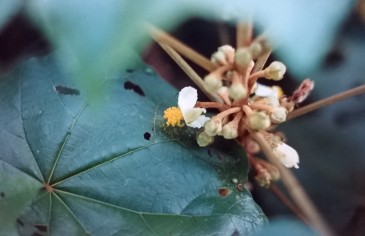Hampea platanifolia Standley
Malvaceae MAJAGUA
Occasional understory evergreen treelet (5 m) found amid well-insolated secondary growth and in forest light gaps. This species is of extremely limited distribution: endemic to Costa Rica, it is found only in the south-western corner of this country.
 Description: Majagua is a small tree with a thin trunk (5 cm). When young it is usually monopodial, bearing a narrow crown of large, long-petioled leaves. More mature specimens sport significant side-branching and often come to resemble large, wide shrubs. The bark is tan, smooth, and composed of tough, stringy, hemp-like fibers. Leaves are large (reaching 40 cm long by 25 cm wide), simple, and alternately arranged. Their long petioles (11 cm) and palmate leaf veins are thickly covered with fine, tan-colored pubescence. Ending in three shallow lobes, the papery blades slightly resemble those of a typical Maple tree. New foliage begins to emerge in April – marking the beginning of the tree’s fertility cycle – with growth continuing until the start of the next dry season in December. Relatively short-stalked flowers (2 cm) emerge from current leaf axils in small clusters. Each has five large, white petals that open and fold back, surrounding and covering the inferior ovary and pedestal. From the flower’s center, a geyser-like assemblage of numerous yellow stamens appears to thrust forth. Flowering in Hampea is a well synchronized, annual event of uniform intensity from season to season. Blossoms are observed from August through January. Fruits (6 cm) grow rapidly and mature as pale-green, oblong capsules. When mature, the woody pods dehisce into three longitudinal sections. Inside, a large number of glossy black seeds –
Description: Majagua is a small tree with a thin trunk (5 cm). When young it is usually monopodial, bearing a narrow crown of large, long-petioled leaves. More mature specimens sport significant side-branching and often come to resemble large, wide shrubs. The bark is tan, smooth, and composed of tough, stringy, hemp-like fibers. Leaves are large (reaching 40 cm long by 25 cm wide), simple, and alternately arranged. Their long petioles (11 cm) and palmate leaf veins are thickly covered with fine, tan-colored pubescence. Ending in three shallow lobes, the papery blades slightly resemble those of a typical Maple tree. New foliage begins to emerge in April – marking the beginning of the tree’s fertility cycle – with growth continuing until the start of the next dry season in December. Relatively short-stalked flowers (2 cm) emerge from current leaf axils in small clusters. Each has five large, white petals that open and fold back, surrounding and covering the inferior ovary and pedestal. From the flower’s center, a geyser-like assemblage of numerous yellow stamens appears to thrust forth. Flowering in Hampea is a well synchronized, annual event of uniform intensity from season to season. Blossoms are observed from August through January. Fruits (6 cm) grow rapidly and mature as pale-green, oblong capsules. When mature, the woody pods dehisce into three longitudinal sections. Inside, a large number of glossy black seeds – resembling raw popcorn in size, shape and texture – can be seen. Each is half embedded in a spongy, snow-white aril. Arranged in rows along the length of the capsule, the ariled seeds present a contrasting display of color and texture. Harvests are annual and consistent in size, lasting from January through March. Old pods may persist on the trees into July.
resembling raw popcorn in size, shape and texture – can be seen. Each is half embedded in a spongy, snow-white aril. Arranged in rows along the length of the capsule, the ariled seeds present a contrasting display of color and texture. Harvests are annual and consistent in size, lasting from January through March. Old pods may persist on the trees into July.
Similar Species: Young Balsa trees, having similarly shaped, large leaves and monopodial trunks, may be confused with mature Majaguas. Fortunately, Majagua is fertile during eight months of the year and its old fruit pods persist on the boles nearly until the flowers re-appear the following season. The presence of these structures provides a reliable means of identification. Less obviously, the basal portion of the Majagua blade parallels the petiole for a few centimeters, forming a distinctly curved pair of proximal leaf lobes. Balsa blades unite immediately with the petiole and do not form such structures.
Natural History: Majagua flowers are pollinated by bees and other insects. Its fruits are dispersed by birds and small mammals (especially squirrels) that seek out the juicy arils surrounding the seeds. Majagua trees maintain active growth from April to December.  During this time, new leaves are produced from the tops of the trees while older ones are continuously being shed from the bottom. Though flower buds appear in the leaf axils of the fresh foliage, by the time the fruits have matured the tree’s rapid growth has left them behind. Ripe pods thus find themselves exposed along the leafless portion of the trunk – beneath the foliated crown. Such positioning improves the visibility of the seed pods, aiding in their dispersal.
During this time, new leaves are produced from the tops of the trees while older ones are continuously being shed from the bottom. Though flower buds appear in the leaf axils of the fresh foliage, by the time the fruits have matured the tree’s rapid growth has left them behind. Ripe pods thus find themselves exposed along the leafless portion of the trunk – beneath the foliated crown. Such positioning improves the visibility of the seed pods, aiding in their dispersal.
Uses: Majagua’s fibrous inner bark may be used as raw material for twine and rope weaving. The tree is an important food producing species for many native birds and mammals. A secondary species tolerant of harsh, exposed tropical conditions, Majagua could have potential as a component of a reforestation program that mimics natural successional processes.
Distribution: Majagua is found commonly along trails and stream banks. It also makes rare appearances inside the deep forest where light gaps occur. The tree is endemic to Costa Rica, where it is restricted to the southwestern Pacific lowlands.
